Law for Social Work: A Critical Analysis of Legal Context in Australia
VerifiedAdded on 2023/06/12
|11
|2781
|190
Essay
AI Summary
This essay provides a critical analysis of the legal context of social work in Australia, focusing on legislation like the Employment Act, Age Discrimination Act, and Disability Discrimination Act. It examines how these laws fund and regulate social work practices, particularly in employment, and their connection to human rights and social justice frameworks. The analysis includes monitoring requirements, special duties of care, and the influence of political pressures on policy changes. It also explores the role of human rights and social justice in shaping policy intentions and implementation strategies, emphasizing the importance of empirical, theoretical, procedural, and self-knowledge for effective social work practice. The essay concludes by highlighting the need for ongoing policy changes to address discrimination in the workplace.
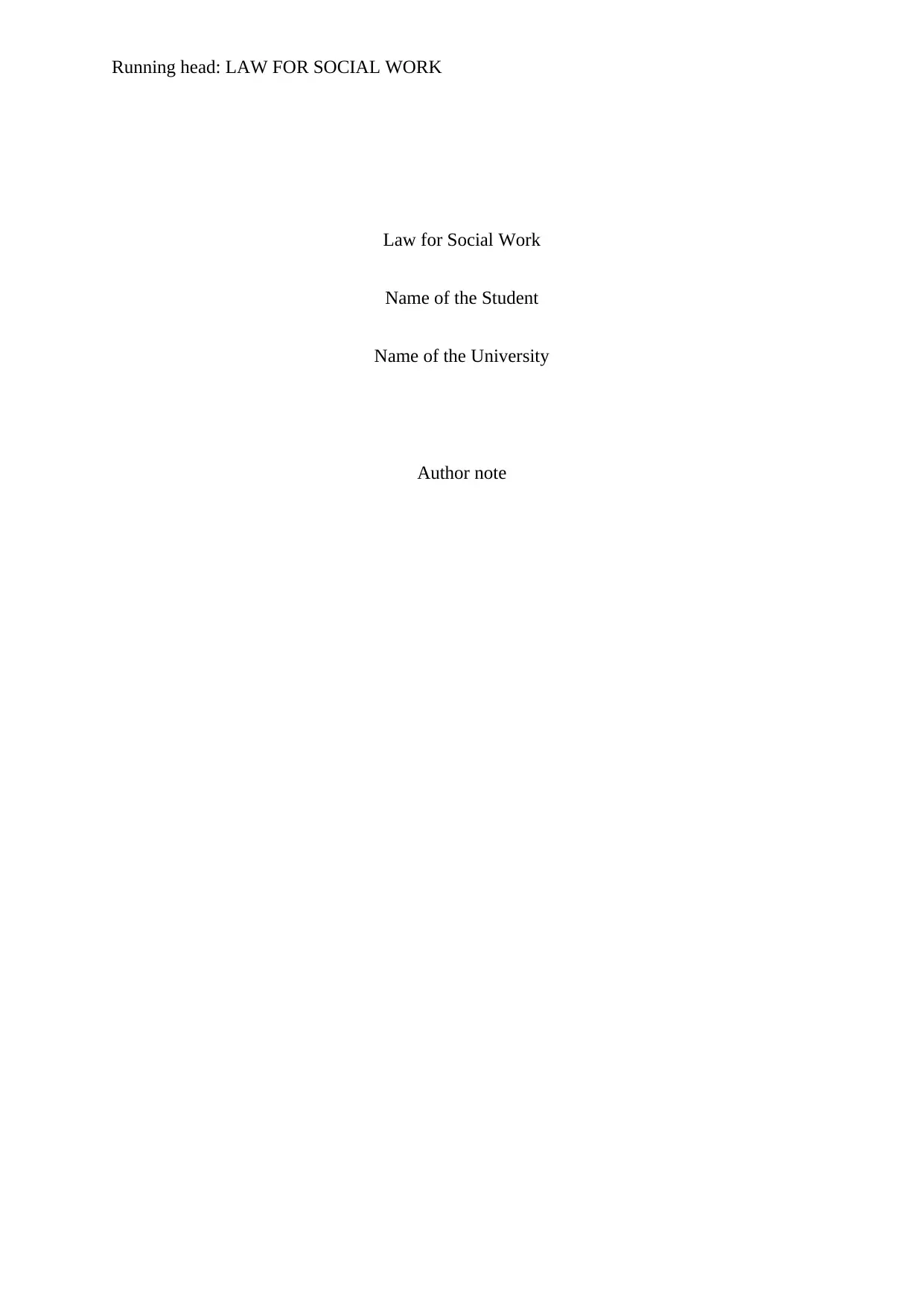
Running head: LAW FOR SOCIAL WORK
Law for Social Work
Name of the Student
Name of the University
Author note
Law for Social Work
Name of the Student
Name of the University
Author note
Paraphrase This Document
Need a fresh take? Get an instant paraphrase of this document with our AI Paraphraser
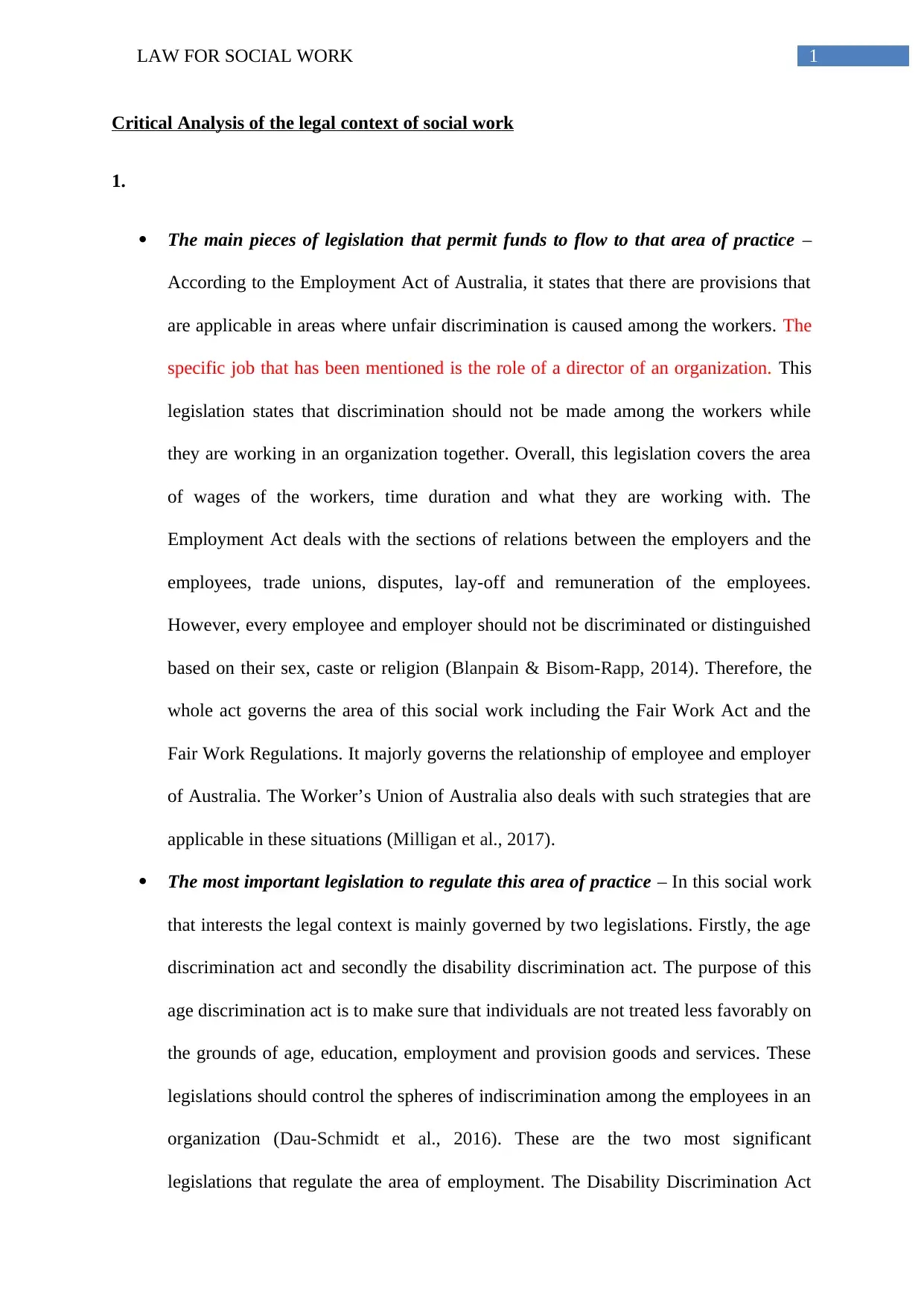
1LAW FOR SOCIAL WORK
Critical Analysis of the legal context of social work
1.
The main pieces of legislation that permit funds to flow to that area of practice –
According to the Employment Act of Australia, it states that there are provisions that
are applicable in areas where unfair discrimination is caused among the workers. The
specific job that has been mentioned is the role of a director of an organization. This
legislation states that discrimination should not be made among the workers while
they are working in an organization together. Overall, this legislation covers the area
of wages of the workers, time duration and what they are working with. The
Employment Act deals with the sections of relations between the employers and the
employees, trade unions, disputes, lay-off and remuneration of the employees.
However, every employee and employer should not be discriminated or distinguished
based on their sex, caste or religion (Blanpain & Bisom-Rapp, 2014). Therefore, the
whole act governs the area of this social work including the Fair Work Act and the
Fair Work Regulations. It majorly governs the relationship of employee and employer
of Australia. The Worker’s Union of Australia also deals with such strategies that are
applicable in these situations (Milligan et al., 2017).
The most important legislation to regulate this area of practice – In this social work
that interests the legal context is mainly governed by two legislations. Firstly, the age
discrimination act and secondly the disability discrimination act. The purpose of this
age discrimination act is to make sure that individuals are not treated less favorably on
the grounds of age, education, employment and provision goods and services. These
legislations should control the spheres of indiscrimination among the employees in an
organization (Dau-Schmidt et al., 2016). These are the two most significant
legislations that regulate the area of employment. The Disability Discrimination Act
Critical Analysis of the legal context of social work
1.
The main pieces of legislation that permit funds to flow to that area of practice –
According to the Employment Act of Australia, it states that there are provisions that
are applicable in areas where unfair discrimination is caused among the workers. The
specific job that has been mentioned is the role of a director of an organization. This
legislation states that discrimination should not be made among the workers while
they are working in an organization together. Overall, this legislation covers the area
of wages of the workers, time duration and what they are working with. The
Employment Act deals with the sections of relations between the employers and the
employees, trade unions, disputes, lay-off and remuneration of the employees.
However, every employee and employer should not be discriminated or distinguished
based on their sex, caste or religion (Blanpain & Bisom-Rapp, 2014). Therefore, the
whole act governs the area of this social work including the Fair Work Act and the
Fair Work Regulations. It majorly governs the relationship of employee and employer
of Australia. The Worker’s Union of Australia also deals with such strategies that are
applicable in these situations (Milligan et al., 2017).
The most important legislation to regulate this area of practice – In this social work
that interests the legal context is mainly governed by two legislations. Firstly, the age
discrimination act and secondly the disability discrimination act. The purpose of this
age discrimination act is to make sure that individuals are not treated less favorably on
the grounds of age, education, employment and provision goods and services. These
legislations should control the spheres of indiscrimination among the employees in an
organization (Dau-Schmidt et al., 2016). These are the two most significant
legislations that regulate the area of employment. The Disability Discrimination Act
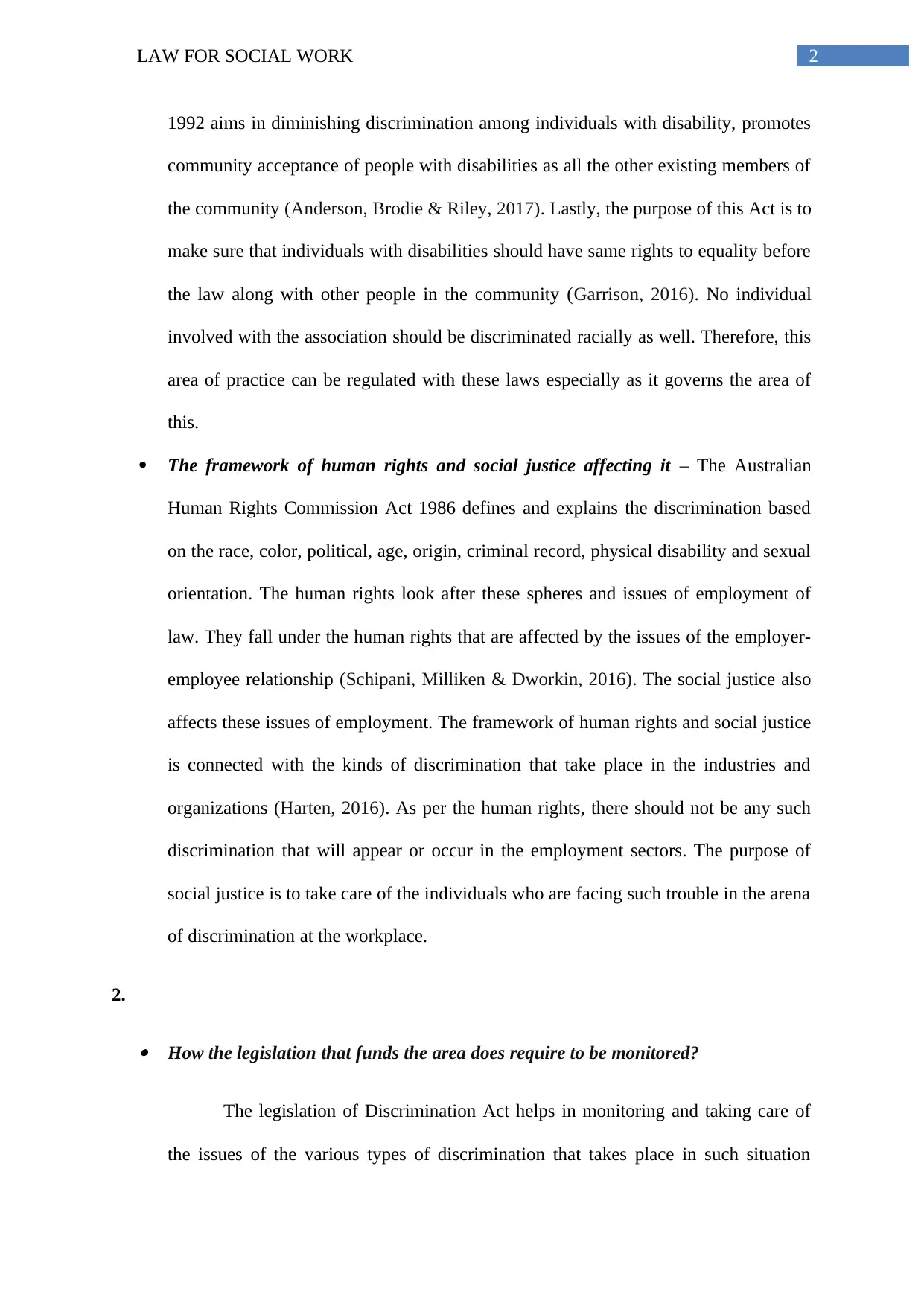
2LAW FOR SOCIAL WORK
1992 aims in diminishing discrimination among individuals with disability, promotes
community acceptance of people with disabilities as all the other existing members of
the community (Anderson, Brodie & Riley, 2017). Lastly, the purpose of this Act is to
make sure that individuals with disabilities should have same rights to equality before
the law along with other people in the community (Garrison, 2016). No individual
involved with the association should be discriminated racially as well. Therefore, this
area of practice can be regulated with these laws especially as it governs the area of
this.
The framework of human rights and social justice affecting it – The Australian
Human Rights Commission Act 1986 defines and explains the discrimination based
on the race, color, political, age, origin, criminal record, physical disability and sexual
orientation. The human rights look after these spheres and issues of employment of
law. They fall under the human rights that are affected by the issues of the employer-
employee relationship (Schipani, Milliken & Dworkin, 2016). The social justice also
affects these issues of employment. The framework of human rights and social justice
is connected with the kinds of discrimination that take place in the industries and
organizations (Harten, 2016). As per the human rights, there should not be any such
discrimination that will appear or occur in the employment sectors. The purpose of
social justice is to take care of the individuals who are facing such trouble in the arena
of discrimination at the workplace.
2.
How the legislation that funds the area does require to be monitored?
The legislation of Discrimination Act helps in monitoring and taking care of
the issues of the various types of discrimination that takes place in such situation
1992 aims in diminishing discrimination among individuals with disability, promotes
community acceptance of people with disabilities as all the other existing members of
the community (Anderson, Brodie & Riley, 2017). Lastly, the purpose of this Act is to
make sure that individuals with disabilities should have same rights to equality before
the law along with other people in the community (Garrison, 2016). No individual
involved with the association should be discriminated racially as well. Therefore, this
area of practice can be regulated with these laws especially as it governs the area of
this.
The framework of human rights and social justice affecting it – The Australian
Human Rights Commission Act 1986 defines and explains the discrimination based
on the race, color, political, age, origin, criminal record, physical disability and sexual
orientation. The human rights look after these spheres and issues of employment of
law. They fall under the human rights that are affected by the issues of the employer-
employee relationship (Schipani, Milliken & Dworkin, 2016). The social justice also
affects these issues of employment. The framework of human rights and social justice
is connected with the kinds of discrimination that take place in the industries and
organizations (Harten, 2016). As per the human rights, there should not be any such
discrimination that will appear or occur in the employment sectors. The purpose of
social justice is to take care of the individuals who are facing such trouble in the arena
of discrimination at the workplace.
2.
How the legislation that funds the area does require to be monitored?
The legislation of Discrimination Act helps in monitoring and taking care of
the issues of the various types of discrimination that takes place in such situation
⊘ This is a preview!⊘
Do you want full access?
Subscribe today to unlock all pages.

Trusted by 1+ million students worldwide
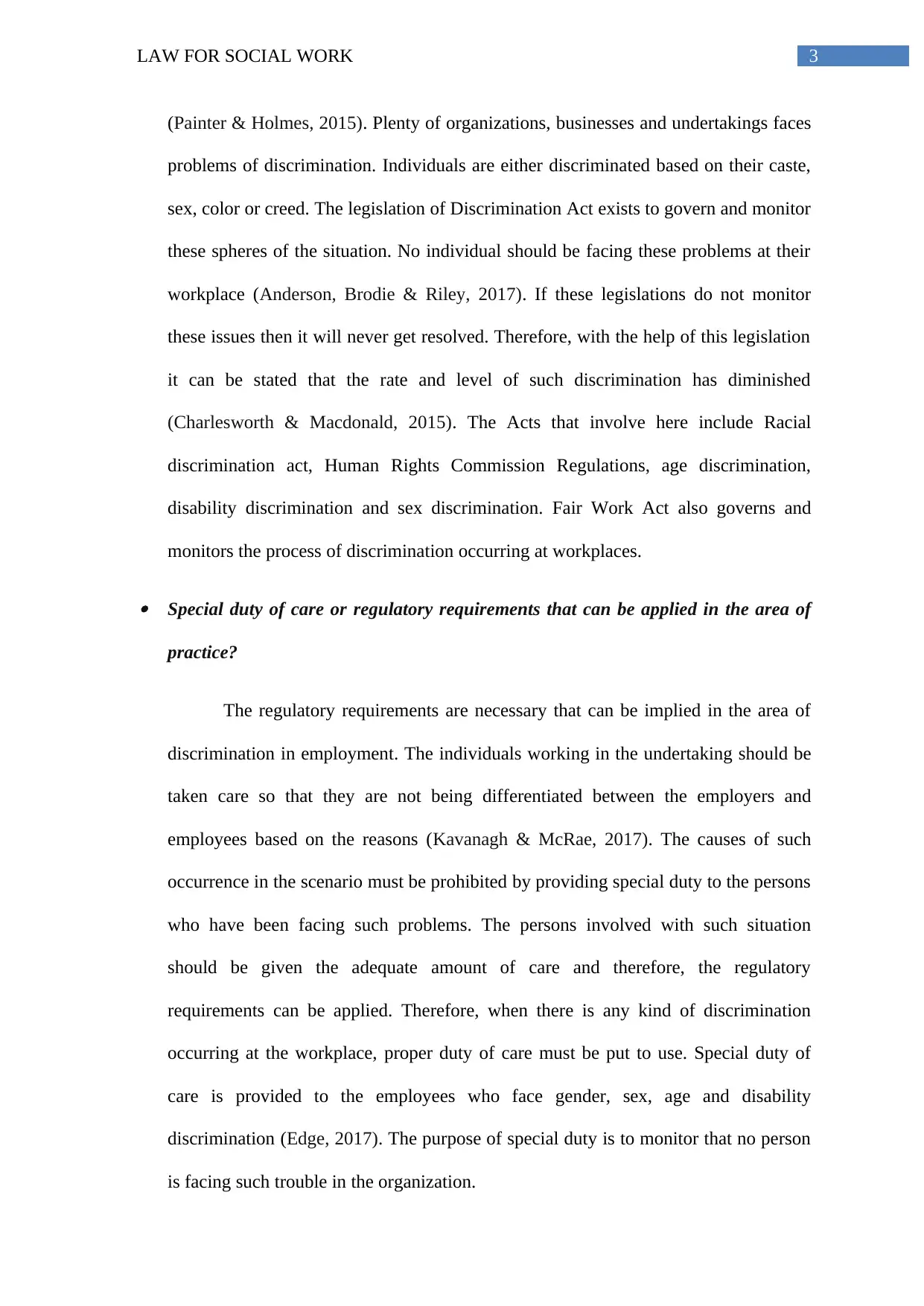
3LAW FOR SOCIAL WORK
(Painter & Holmes, 2015). Plenty of organizations, businesses and undertakings faces
problems of discrimination. Individuals are either discriminated based on their caste,
sex, color or creed. The legislation of Discrimination Act exists to govern and monitor
these spheres of the situation. No individual should be facing these problems at their
workplace (Anderson, Brodie & Riley, 2017). If these legislations do not monitor
these issues then it will never get resolved. Therefore, with the help of this legislation
it can be stated that the rate and level of such discrimination has diminished
(Charlesworth & Macdonald, 2015). The Acts that involve here include Racial
discrimination act, Human Rights Commission Regulations, age discrimination,
disability discrimination and sex discrimination. Fair Work Act also governs and
monitors the process of discrimination occurring at workplaces.
Special duty of care or regulatory requirements that can be applied in the area of
practice?
The regulatory requirements are necessary that can be implied in the area of
discrimination in employment. The individuals working in the undertaking should be
taken care so that they are not being differentiated between the employers and
employees based on the reasons (Kavanagh & McRae, 2017). The causes of such
occurrence in the scenario must be prohibited by providing special duty to the persons
who have been facing such problems. The persons involved with such situation
should be given the adequate amount of care and therefore, the regulatory
requirements can be applied. Therefore, when there is any kind of discrimination
occurring at the workplace, proper duty of care must be put to use. Special duty of
care is provided to the employees who face gender, sex, age and disability
discrimination (Edge, 2017). The purpose of special duty is to monitor that no person
is facing such trouble in the organization.
(Painter & Holmes, 2015). Plenty of organizations, businesses and undertakings faces
problems of discrimination. Individuals are either discriminated based on their caste,
sex, color or creed. The legislation of Discrimination Act exists to govern and monitor
these spheres of the situation. No individual should be facing these problems at their
workplace (Anderson, Brodie & Riley, 2017). If these legislations do not monitor
these issues then it will never get resolved. Therefore, with the help of this legislation
it can be stated that the rate and level of such discrimination has diminished
(Charlesworth & Macdonald, 2015). The Acts that involve here include Racial
discrimination act, Human Rights Commission Regulations, age discrimination,
disability discrimination and sex discrimination. Fair Work Act also governs and
monitors the process of discrimination occurring at workplaces.
Special duty of care or regulatory requirements that can be applied in the area of
practice?
The regulatory requirements are necessary that can be implied in the area of
discrimination in employment. The individuals working in the undertaking should be
taken care so that they are not being differentiated between the employers and
employees based on the reasons (Kavanagh & McRae, 2017). The causes of such
occurrence in the scenario must be prohibited by providing special duty to the persons
who have been facing such problems. The persons involved with such situation
should be given the adequate amount of care and therefore, the regulatory
requirements can be applied. Therefore, when there is any kind of discrimination
occurring at the workplace, proper duty of care must be put to use. Special duty of
care is provided to the employees who face gender, sex, age and disability
discrimination (Edge, 2017). The purpose of special duty is to monitor that no person
is facing such trouble in the organization.
Paraphrase This Document
Need a fresh take? Get an instant paraphrase of this document with our AI Paraphraser
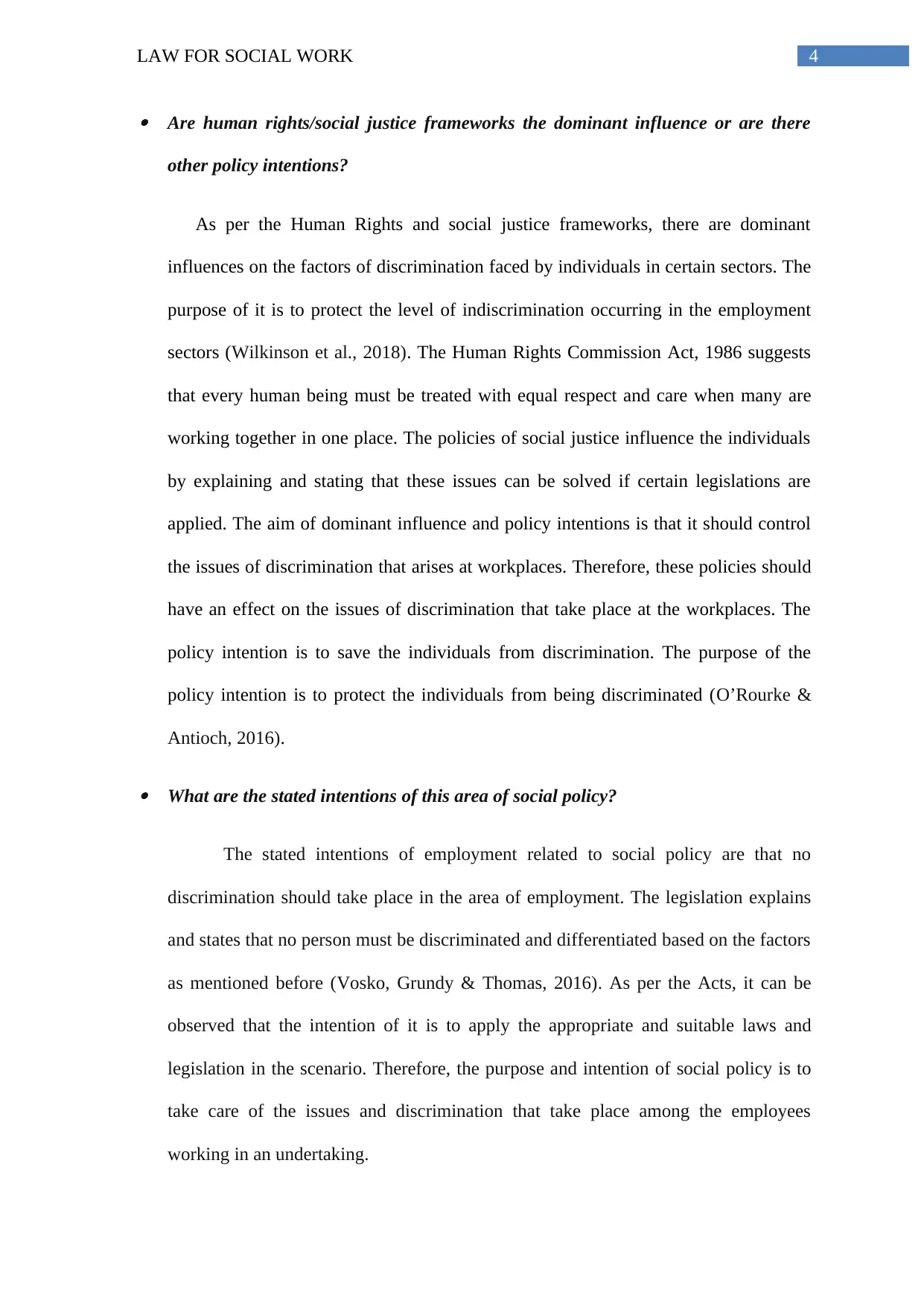
4LAW FOR SOCIAL WORK
Are human rights/social justice frameworks the dominant influence or are there
other policy intentions?
As per the Human Rights and social justice frameworks, there are dominant
influences on the factors of discrimination faced by individuals in certain sectors. The
purpose of it is to protect the level of indiscrimination occurring in the employment
sectors (Wilkinson et al., 2018). The Human Rights Commission Act, 1986 suggests
that every human being must be treated with equal respect and care when many are
working together in one place. The policies of social justice influence the individuals
by explaining and stating that these issues can be solved if certain legislations are
applied. The aim of dominant influence and policy intentions is that it should control
the issues of discrimination that arises at workplaces. Therefore, these policies should
have an effect on the issues of discrimination that take place at the workplaces. The
policy intention is to save the individuals from discrimination. The purpose of the
policy intention is to protect the individuals from being discriminated (O’Rourke &
Antioch, 2016).
What are the stated intentions of this area of social policy?
The stated intentions of employment related to social policy are that no
discrimination should take place in the area of employment. The legislation explains
and states that no person must be discriminated and differentiated based on the factors
as mentioned before (Vosko, Grundy & Thomas, 2016). As per the Acts, it can be
observed that the intention of it is to apply the appropriate and suitable laws and
legislation in the scenario. Therefore, the purpose and intention of social policy is to
take care of the issues and discrimination that take place among the employees
working in an undertaking.
Are human rights/social justice frameworks the dominant influence or are there
other policy intentions?
As per the Human Rights and social justice frameworks, there are dominant
influences on the factors of discrimination faced by individuals in certain sectors. The
purpose of it is to protect the level of indiscrimination occurring in the employment
sectors (Wilkinson et al., 2018). The Human Rights Commission Act, 1986 suggests
that every human being must be treated with equal respect and care when many are
working together in one place. The policies of social justice influence the individuals
by explaining and stating that these issues can be solved if certain legislations are
applied. The aim of dominant influence and policy intentions is that it should control
the issues of discrimination that arises at workplaces. Therefore, these policies should
have an effect on the issues of discrimination that take place at the workplaces. The
policy intention is to save the individuals from discrimination. The purpose of the
policy intention is to protect the individuals from being discriminated (O’Rourke &
Antioch, 2016).
What are the stated intentions of this area of social policy?
The stated intentions of employment related to social policy are that no
discrimination should take place in the area of employment. The legislation explains
and states that no person must be discriminated and differentiated based on the factors
as mentioned before (Vosko, Grundy & Thomas, 2016). As per the Acts, it can be
observed that the intention of it is to apply the appropriate and suitable laws and
legislation in the scenario. Therefore, the purpose and intention of social policy is to
take care of the issues and discrimination that take place among the employees
working in an undertaking.
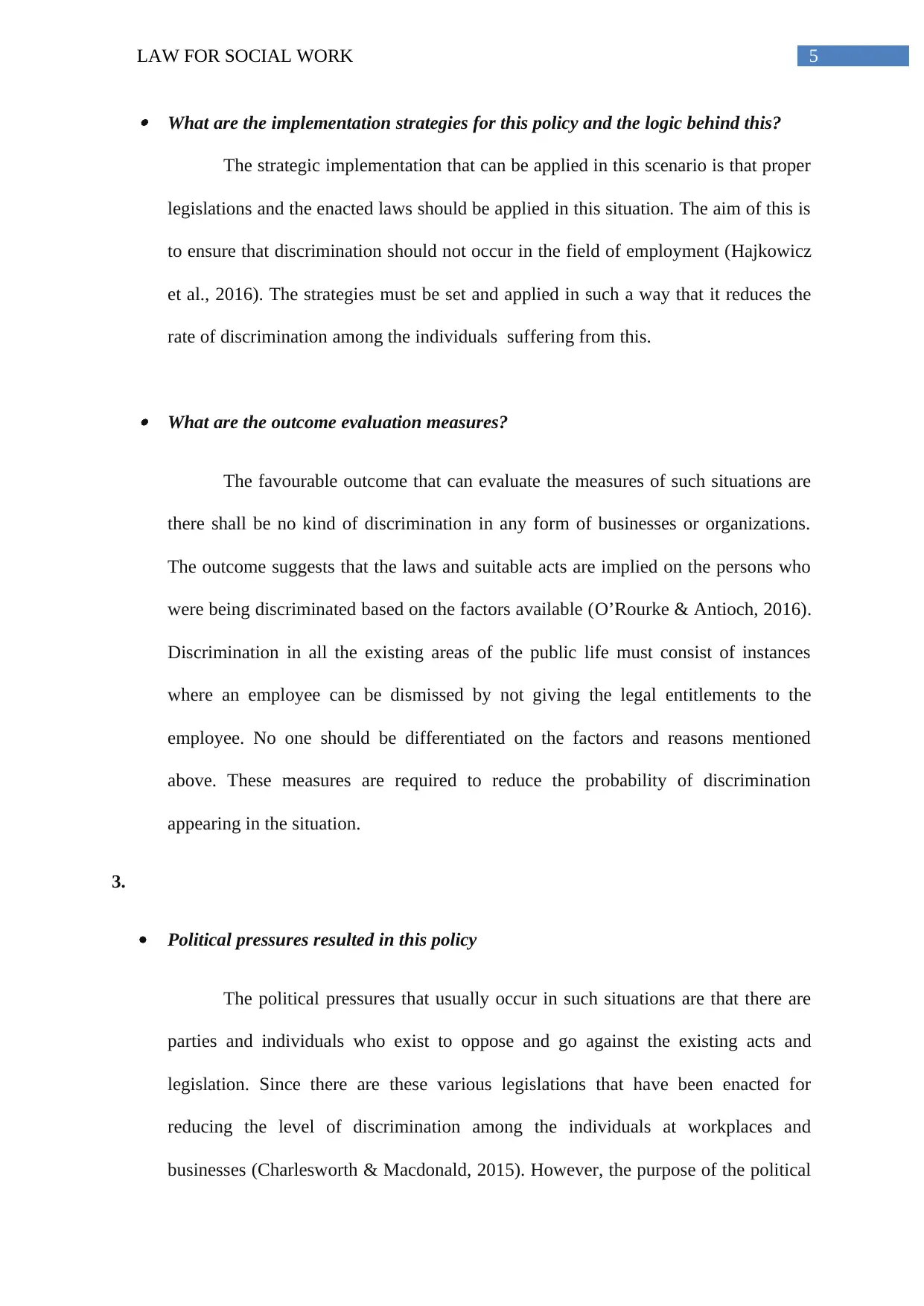
5LAW FOR SOCIAL WORK
What are the implementation strategies for this policy and the logic behind this?
The strategic implementation that can be applied in this scenario is that proper
legislations and the enacted laws should be applied in this situation. The aim of this is
to ensure that discrimination should not occur in the field of employment (Hajkowicz
et al., 2016). The strategies must be set and applied in such a way that it reduces the
rate of discrimination among the individuals suffering from this.
What are the outcome evaluation measures?
The favourable outcome that can evaluate the measures of such situations are
there shall be no kind of discrimination in any form of businesses or organizations.
The outcome suggests that the laws and suitable acts are implied on the persons who
were being discriminated based on the factors available (O’Rourke & Antioch, 2016).
Discrimination in all the existing areas of the public life must consist of instances
where an employee can be dismissed by not giving the legal entitlements to the
employee. No one should be differentiated on the factors and reasons mentioned
above. These measures are required to reduce the probability of discrimination
appearing in the situation.
3.
Political pressures resulted in this policy
The political pressures that usually occur in such situations are that there are
parties and individuals who exist to oppose and go against the existing acts and
legislation. Since there are these various legislations that have been enacted for
reducing the level of discrimination among the individuals at workplaces and
businesses (Charlesworth & Macdonald, 2015). However, the purpose of the political
What are the implementation strategies for this policy and the logic behind this?
The strategic implementation that can be applied in this scenario is that proper
legislations and the enacted laws should be applied in this situation. The aim of this is
to ensure that discrimination should not occur in the field of employment (Hajkowicz
et al., 2016). The strategies must be set and applied in such a way that it reduces the
rate of discrimination among the individuals suffering from this.
What are the outcome evaluation measures?
The favourable outcome that can evaluate the measures of such situations are
there shall be no kind of discrimination in any form of businesses or organizations.
The outcome suggests that the laws and suitable acts are implied on the persons who
were being discriminated based on the factors available (O’Rourke & Antioch, 2016).
Discrimination in all the existing areas of the public life must consist of instances
where an employee can be dismissed by not giving the legal entitlements to the
employee. No one should be differentiated on the factors and reasons mentioned
above. These measures are required to reduce the probability of discrimination
appearing in the situation.
3.
Political pressures resulted in this policy
The political pressures that usually occur in such situations are that there are
parties and individuals who exist to oppose and go against the existing acts and
legislation. Since there are these various legislations that have been enacted for
reducing the level of discrimination among the individuals at workplaces and
businesses (Charlesworth & Macdonald, 2015). However, the purpose of the political
⊘ This is a preview!⊘
Do you want full access?
Subscribe today to unlock all pages.

Trusted by 1+ million students worldwide
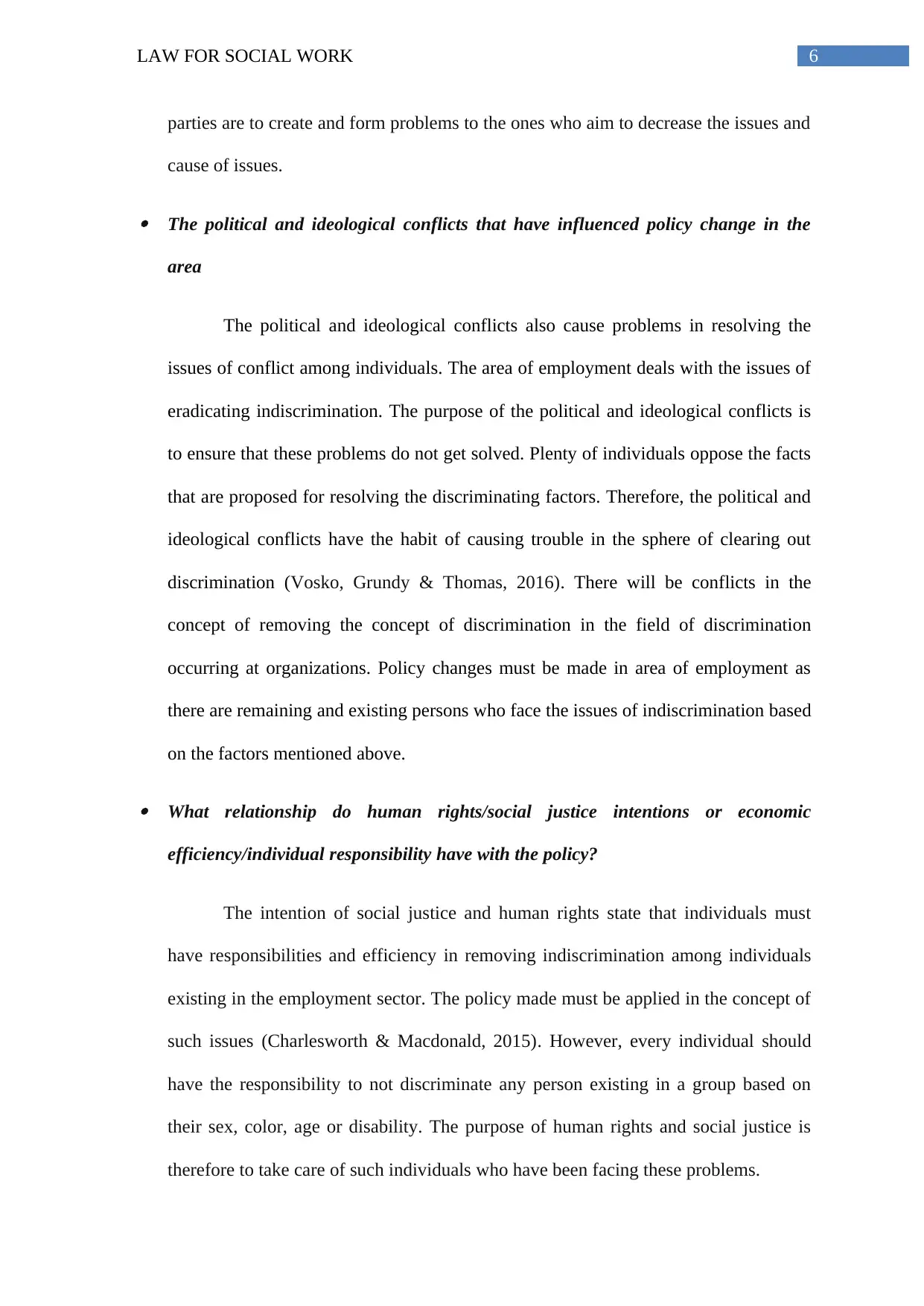
6LAW FOR SOCIAL WORK
parties are to create and form problems to the ones who aim to decrease the issues and
cause of issues.
The political and ideological conflicts that have influenced policy change in the
area
The political and ideological conflicts also cause problems in resolving the
issues of conflict among individuals. The area of employment deals with the issues of
eradicating indiscrimination. The purpose of the political and ideological conflicts is
to ensure that these problems do not get solved. Plenty of individuals oppose the facts
that are proposed for resolving the discriminating factors. Therefore, the political and
ideological conflicts have the habit of causing trouble in the sphere of clearing out
discrimination (Vosko, Grundy & Thomas, 2016). There will be conflicts in the
concept of removing the concept of discrimination in the field of discrimination
occurring at organizations. Policy changes must be made in area of employment as
there are remaining and existing persons who face the issues of indiscrimination based
on the factors mentioned above.
What relationship do human rights/social justice intentions or economic
efficiency/individual responsibility have with the policy?
The intention of social justice and human rights state that individuals must
have responsibilities and efficiency in removing indiscrimination among individuals
existing in the employment sector. The policy made must be applied in the concept of
such issues (Charlesworth & Macdonald, 2015). However, every individual should
have the responsibility to not discriminate any person existing in a group based on
their sex, color, age or disability. The purpose of human rights and social justice is
therefore to take care of such individuals who have been facing these problems.
parties are to create and form problems to the ones who aim to decrease the issues and
cause of issues.
The political and ideological conflicts that have influenced policy change in the
area
The political and ideological conflicts also cause problems in resolving the
issues of conflict among individuals. The area of employment deals with the issues of
eradicating indiscrimination. The purpose of the political and ideological conflicts is
to ensure that these problems do not get solved. Plenty of individuals oppose the facts
that are proposed for resolving the discriminating factors. Therefore, the political and
ideological conflicts have the habit of causing trouble in the sphere of clearing out
discrimination (Vosko, Grundy & Thomas, 2016). There will be conflicts in the
concept of removing the concept of discrimination in the field of discrimination
occurring at organizations. Policy changes must be made in area of employment as
there are remaining and existing persons who face the issues of indiscrimination based
on the factors mentioned above.
What relationship do human rights/social justice intentions or economic
efficiency/individual responsibility have with the policy?
The intention of social justice and human rights state that individuals must
have responsibilities and efficiency in removing indiscrimination among individuals
existing in the employment sector. The policy made must be applied in the concept of
such issues (Charlesworth & Macdonald, 2015). However, every individual should
have the responsibility to not discriminate any person existing in a group based on
their sex, color, age or disability. The purpose of human rights and social justice is
therefore to take care of such individuals who have been facing these problems.
Paraphrase This Document
Need a fresh take? Get an instant paraphrase of this document with our AI Paraphraser
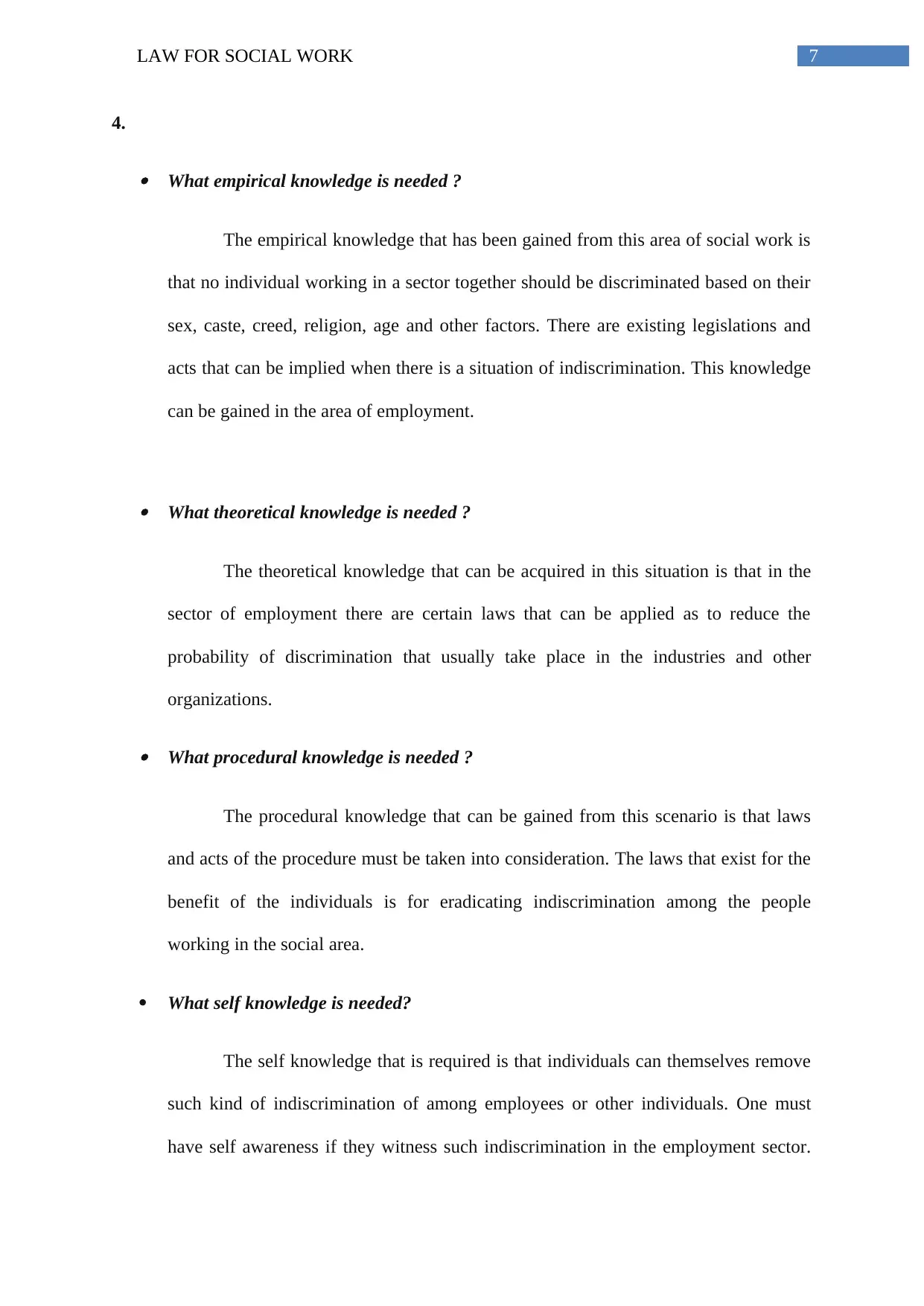
7LAW FOR SOCIAL WORK
4.
What empirical knowledge is needed ?
The empirical knowledge that has been gained from this area of social work is
that no individual working in a sector together should be discriminated based on their
sex, caste, creed, religion, age and other factors. There are existing legislations and
acts that can be implied when there is a situation of indiscrimination. This knowledge
can be gained in the area of employment.
What theoretical knowledge is needed ?
The theoretical knowledge that can be acquired in this situation is that in the
sector of employment there are certain laws that can be applied as to reduce the
probability of discrimination that usually take place in the industries and other
organizations.
What procedural knowledge is needed ?
The procedural knowledge that can be gained from this scenario is that laws
and acts of the procedure must be taken into consideration. The laws that exist for the
benefit of the individuals is for eradicating indiscrimination among the people
working in the social area.
What self knowledge is needed?
The self knowledge that is required is that individuals can themselves remove
such kind of indiscrimination of among employees or other individuals. One must
have self awareness if they witness such indiscrimination in the employment sector.
4.
What empirical knowledge is needed ?
The empirical knowledge that has been gained from this area of social work is
that no individual working in a sector together should be discriminated based on their
sex, caste, creed, religion, age and other factors. There are existing legislations and
acts that can be implied when there is a situation of indiscrimination. This knowledge
can be gained in the area of employment.
What theoretical knowledge is needed ?
The theoretical knowledge that can be acquired in this situation is that in the
sector of employment there are certain laws that can be applied as to reduce the
probability of discrimination that usually take place in the industries and other
organizations.
What procedural knowledge is needed ?
The procedural knowledge that can be gained from this scenario is that laws
and acts of the procedure must be taken into consideration. The laws that exist for the
benefit of the individuals is for eradicating indiscrimination among the people
working in the social area.
What self knowledge is needed?
The self knowledge that is required is that individuals can themselves remove
such kind of indiscrimination of among employees or other individuals. One must
have self awareness if they witness such indiscrimination in the employment sector.
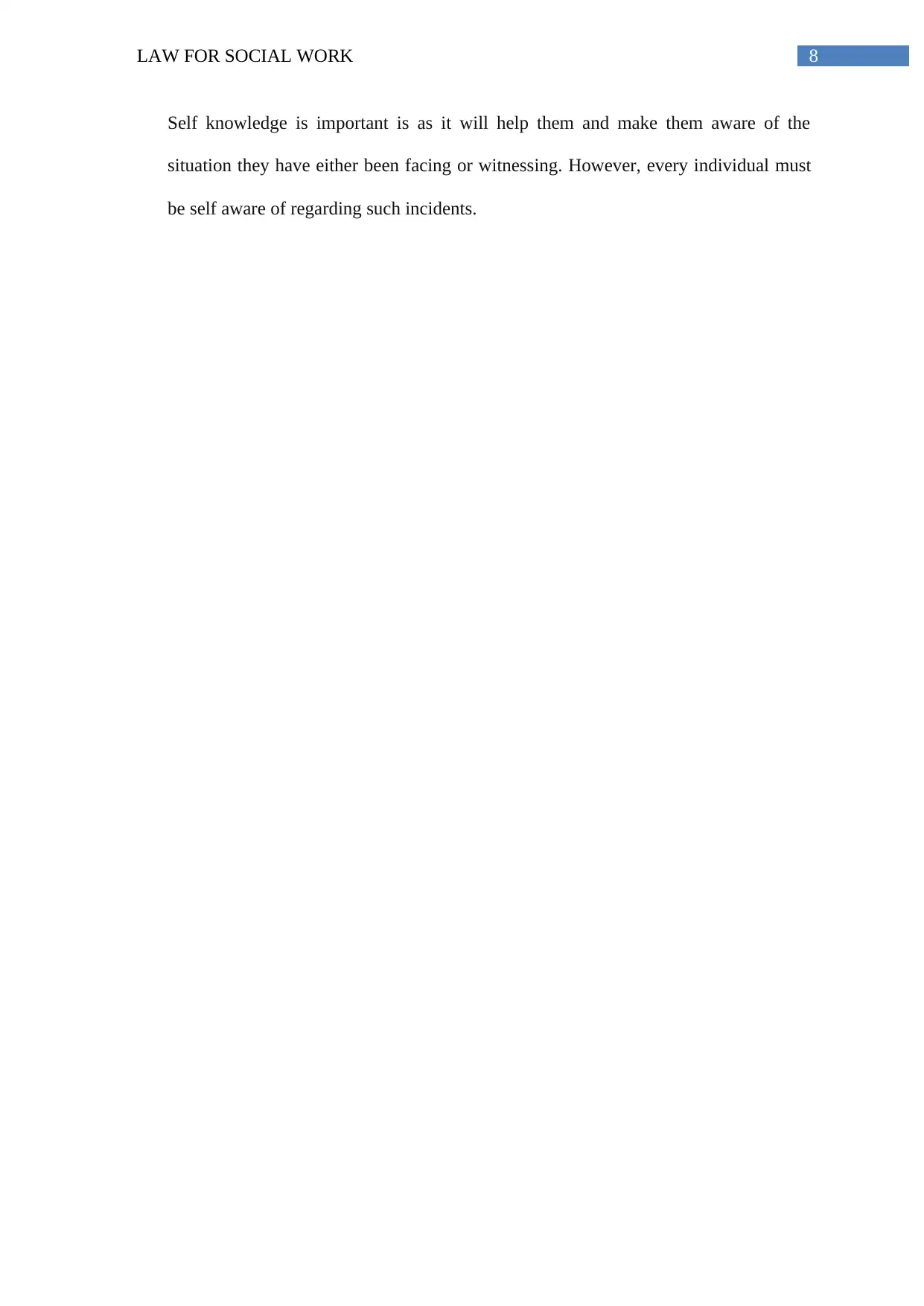
8LAW FOR SOCIAL WORK
Self knowledge is important is as it will help them and make them aware of the
situation they have either been facing or witnessing. However, every individual must
be self aware of regarding such incidents.
Self knowledge is important is as it will help them and make them aware of the
situation they have either been facing or witnessing. However, every individual must
be self aware of regarding such incidents.
⊘ This is a preview!⊘
Do you want full access?
Subscribe today to unlock all pages.

Trusted by 1+ million students worldwide
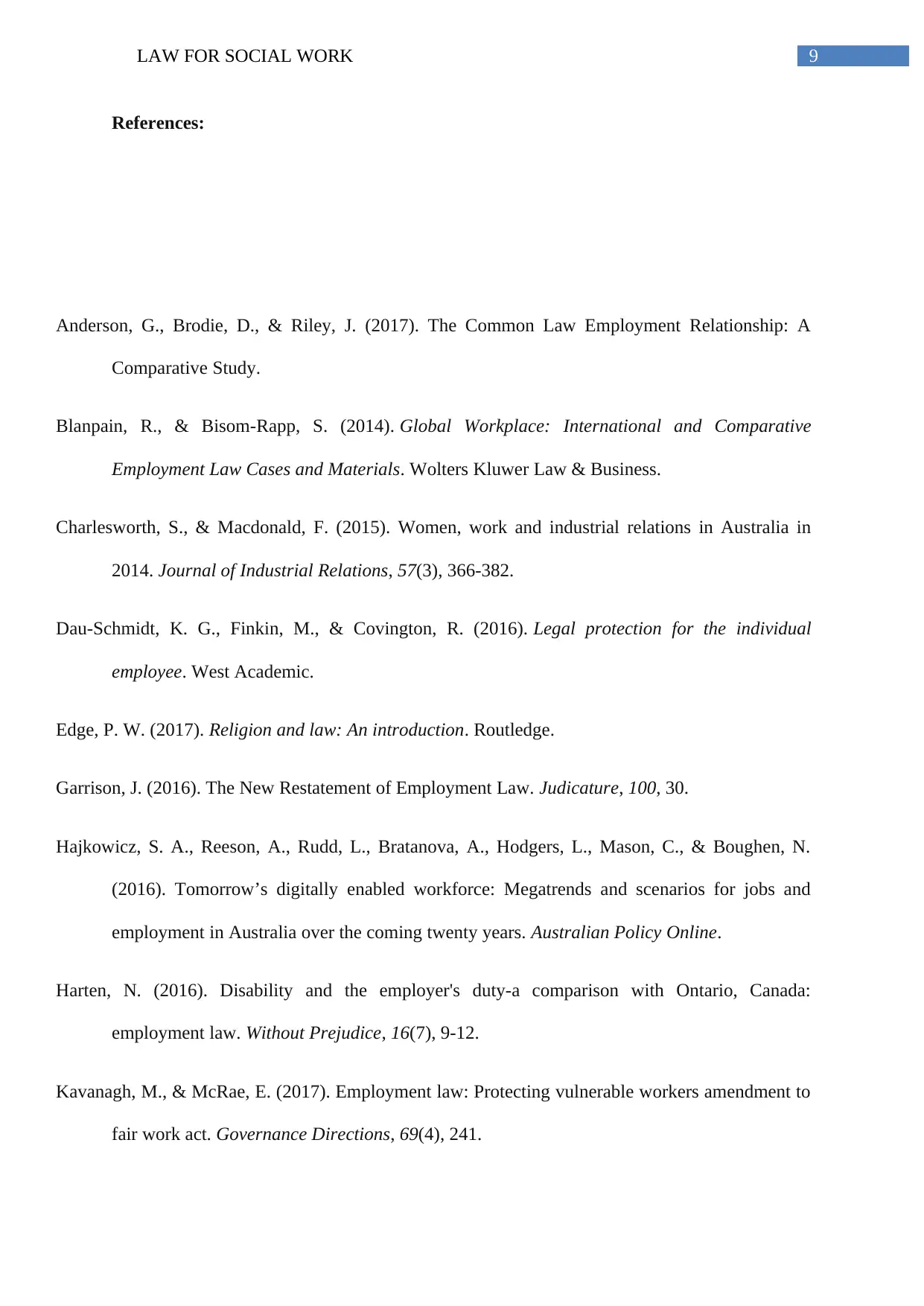
9LAW FOR SOCIAL WORK
References:
Anderson, G., Brodie, D., & Riley, J. (2017). The Common Law Employment Relationship: A
Comparative Study.
Blanpain, R., & Bisom-Rapp, S. (2014). Global Workplace: International and Comparative
Employment Law Cases and Materials. Wolters Kluwer Law & Business.
Charlesworth, S., & Macdonald, F. (2015). Women, work and industrial relations in Australia in
2014. Journal of Industrial Relations, 57(3), 366-382.
Dau-Schmidt, K. G., Finkin, M., & Covington, R. (2016). Legal protection for the individual
employee. West Academic.
Edge, P. W. (2017). Religion and law: An introduction. Routledge.
Garrison, J. (2016). The New Restatement of Employment Law. Judicature, 100, 30.
Hajkowicz, S. A., Reeson, A., Rudd, L., Bratanova, A., Hodgers, L., Mason, C., & Boughen, N.
(2016). Tomorrow’s digitally enabled workforce: Megatrends and scenarios for jobs and
employment in Australia over the coming twenty years. Australian Policy Online.
Harten, N. (2016). Disability and the employer's duty-a comparison with Ontario, Canada:
employment law. Without Prejudice, 16(7), 9-12.
Kavanagh, M., & McRae, E. (2017). Employment law: Protecting vulnerable workers amendment to
fair work act. Governance Directions, 69(4), 241.
References:
Anderson, G., Brodie, D., & Riley, J. (2017). The Common Law Employment Relationship: A
Comparative Study.
Blanpain, R., & Bisom-Rapp, S. (2014). Global Workplace: International and Comparative
Employment Law Cases and Materials. Wolters Kluwer Law & Business.
Charlesworth, S., & Macdonald, F. (2015). Women, work and industrial relations in Australia in
2014. Journal of Industrial Relations, 57(3), 366-382.
Dau-Schmidt, K. G., Finkin, M., & Covington, R. (2016). Legal protection for the individual
employee. West Academic.
Edge, P. W. (2017). Religion and law: An introduction. Routledge.
Garrison, J. (2016). The New Restatement of Employment Law. Judicature, 100, 30.
Hajkowicz, S. A., Reeson, A., Rudd, L., Bratanova, A., Hodgers, L., Mason, C., & Boughen, N.
(2016). Tomorrow’s digitally enabled workforce: Megatrends and scenarios for jobs and
employment in Australia over the coming twenty years. Australian Policy Online.
Harten, N. (2016). Disability and the employer's duty-a comparison with Ontario, Canada:
employment law. Without Prejudice, 16(7), 9-12.
Kavanagh, M., & McRae, E. (2017). Employment law: Protecting vulnerable workers amendment to
fair work act. Governance Directions, 69(4), 241.
Paraphrase This Document
Need a fresh take? Get an instant paraphrase of this document with our AI Paraphraser
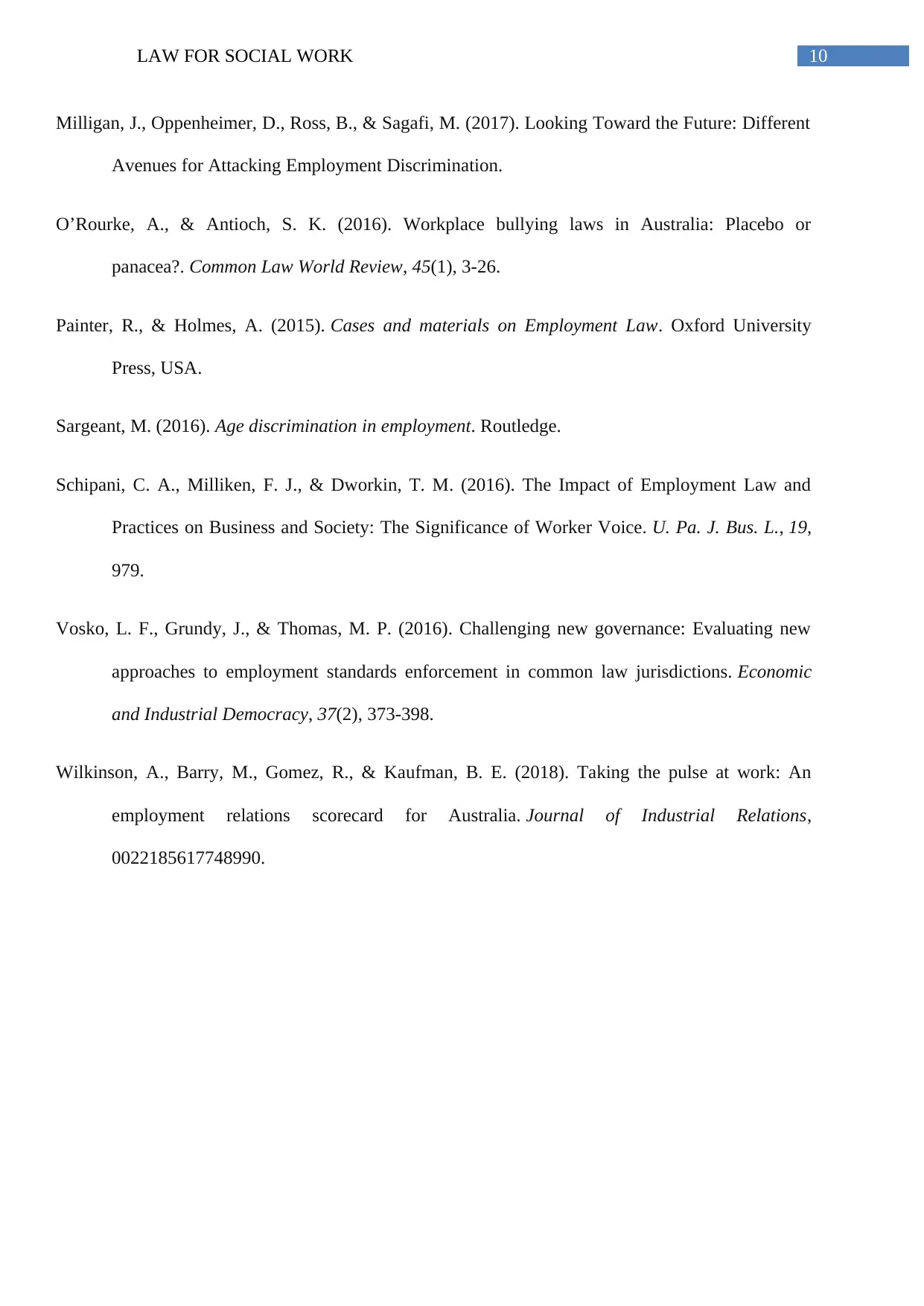
10LAW FOR SOCIAL WORK
Milligan, J., Oppenheimer, D., Ross, B., & Sagafi, M. (2017). Looking Toward the Future: Different
Avenues for Attacking Employment Discrimination.
O’Rourke, A., & Antioch, S. K. (2016). Workplace bullying laws in Australia: Placebo or
panacea?. Common Law World Review, 45(1), 3-26.
Painter, R., & Holmes, A. (2015). Cases and materials on Employment Law. Oxford University
Press, USA.
Sargeant, M. (2016). Age discrimination in employment. Routledge.
Schipani, C. A., Milliken, F. J., & Dworkin, T. M. (2016). The Impact of Employment Law and
Practices on Business and Society: The Significance of Worker Voice. U. Pa. J. Bus. L., 19,
979.
Vosko, L. F., Grundy, J., & Thomas, M. P. (2016). Challenging new governance: Evaluating new
approaches to employment standards enforcement in common law jurisdictions. Economic
and Industrial Democracy, 37(2), 373-398.
Wilkinson, A., Barry, M., Gomez, R., & Kaufman, B. E. (2018). Taking the pulse at work: An
employment relations scorecard for Australia. Journal of Industrial Relations,
0022185617748990.
Milligan, J., Oppenheimer, D., Ross, B., & Sagafi, M. (2017). Looking Toward the Future: Different
Avenues for Attacking Employment Discrimination.
O’Rourke, A., & Antioch, S. K. (2016). Workplace bullying laws in Australia: Placebo or
panacea?. Common Law World Review, 45(1), 3-26.
Painter, R., & Holmes, A. (2015). Cases and materials on Employment Law. Oxford University
Press, USA.
Sargeant, M. (2016). Age discrimination in employment. Routledge.
Schipani, C. A., Milliken, F. J., & Dworkin, T. M. (2016). The Impact of Employment Law and
Practices on Business and Society: The Significance of Worker Voice. U. Pa. J. Bus. L., 19,
979.
Vosko, L. F., Grundy, J., & Thomas, M. P. (2016). Challenging new governance: Evaluating new
approaches to employment standards enforcement in common law jurisdictions. Economic
and Industrial Democracy, 37(2), 373-398.
Wilkinson, A., Barry, M., Gomez, R., & Kaufman, B. E. (2018). Taking the pulse at work: An
employment relations scorecard for Australia. Journal of Industrial Relations,
0022185617748990.
1 out of 11
Related Documents
Your All-in-One AI-Powered Toolkit for Academic Success.
+13062052269
info@desklib.com
Available 24*7 on WhatsApp / Email
![[object Object]](/_next/static/media/star-bottom.7253800d.svg)
Unlock your academic potential
Copyright © 2020–2025 A2Z Services. All Rights Reserved. Developed and managed by ZUCOL.




